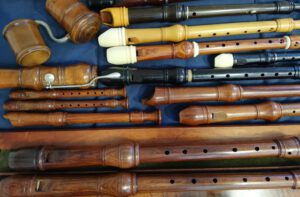Today, most people who think of Dolmetsch recorders have the firm’s “modernized” type of instrument in mind. For a quarter century, 1945-1970 say, these were used by most of the world’s leading players. They were louder, better tuned and more reliable than any others on the market – perfect tools for jobs that needed doing before the historically-informed performance movement took off. Frans Brüggen’s well-publicized switch from the modernized recorder to eighteenth-century originals and copies of them, c.1970, dented the Dolmetsch image and created space for a new generation of makers going back to baroque themselves.
In fact, the majority of Dolmetsch recorders produced before the Second World War were tightly-voiced baroque-style instruments, often with undercut finger holes and arched windways. They were made only at A415 to start with. Customers could order them at A415 or at A440 from about 1930. At either pitch they preserved the playing “feel” of actual baroque recorders remarkably well. Brüggen and the now-famous baroque-revival makers whose instruments he championed so effectively were either unaware of this, or preferred not to admit that Dolmetsch had beaten them to it by 50 years.
Our Dolmetsch 1930s Legacy Project aims to showcase some of the best surviving instruments from that forgotten golden era, allowing listeners today to hear for themselves how well they behave. We are making a series of short videos featuring Dolmetsches exclusively, where possible recorded in venues that date from the same 1930s decade.
Research informing the project, much of it undertaken by Andrew Pinnock of the University of Southampton with whom we are collaborating, is accessible free of charge (no paywall) via the website of The Galpin Society Journal: GSJ-76a Pinnock.pdf (galpinsociety.org) For more on the Dolmetsch story, see the Dolmetsch Online website.
Episode #1 showcases trebles #647 and #648. They were part of a set of low pitch instruments (sopranino to bass) made in or around 1932–3, and probably shipped to Germany soon after as a demonstration set (see picture). They do not seem to have been much played and all except the tenor are in excellent condition. The chosen repertoire is Johann Mattheson’s Sonata XI à Due Flauti (XII Sonates à Deux & Trois Flûtes Sans Basse, Ouvrage 1, Amsterdam 1708). The recording location is the entrance hall to the Broederschool in Sint-Niklaas, Belgium (Art Deco, 1932).
Click here for detailed photos of the instruments used.
Episode #2 features five Dolmetsch recorders made in the 1920s and 30s, and one made by Robert Goble in the late 1940s. Unlike the treble pair used in Episode #1 these are all “high pitch” instruments, at A439/440. The repertoire is taken from two sets of Pièces de Clavecin; by Jean-Philippe Rameau (1724) and Louis-Claude Daquin (1735). Bird-imitative pieces like these were popular in England around 1700 (Bird Fancyer’s Delight etc.), and often appeared in Dolmetsch concert programmes showcasing the recorder. The recording location is the chapel of the former Kartuizerklooster in Ghent (B).
Arnold Dolmetsch’s son Carl did most of the design work needed to ensure that all sizes of recorder worked equally well at high and low pitch, developed very effective sopranino models (half-size trebles, available at high and low pitch from 1931), and gradually adapted designs to production line manufacture. This was the only way to keep up with demand. Recorder “modernization” happened in small, incremental steps through the 1930s: Dolmetsch instruments made before WWII would be very different in character if they were bought a few years apart. To illustrate, Episode #2 pairs instruments in various states of modernization from hardly any (at the baroque-copy end of the spectrum) to near complete.
You can download this arrangement free of charge on the FR2 website.
Le Rappel des Oiseaux | Jean-Philippe Rameau
Dolmetsch sopranino #733, c.1934-5 (JVG); Robert Goble treble #175 (TB). Goble was a Dolmetsch workshop assistant in the 1920s and 30s, and for about a decade after WWII made own-brand recorders very closely modelled on un-modernized Dolmetsch designs. #175 is a fine example.
Rondeau Le Coucoû | Louis-Claude Daquin
Dolmetsch descant #1193, c.1937-8 (JVG); Dolmetsch tenor #267, made in 1929 (TB).
#267 is a very early A439/440 tenor, made for a customer in the USA before high-pitch options were widely advertised.
Rondeau L’Hirondelle | Louis-Claude Daquin
Dolmetsch treble, unnumbered, c.1926 (JVG); Dolmetsch treble #1131, c.1937-8 (TB).
Since Dolmetsch instruments intended for sale carried serial numbers this unnumbered treble was probably a prototype, one of the very first high-pitch Dolmetsch recorders if so. #1131 has prototype characteristics too. Its beak is sheathed in heavy plastic rather than ivory. It has the straight edge and steep ramp found in fully modernized Dolmetsch recorders, but a narrow tapered windway not the wide, parallel-sided “letterbox” type to which Dolmetsch switched after WWII.
For more on A415 vs A439/440 pitch issues, and more about Robert Goble’s recorders, see this article by Andrew Pinnock – accessible free of charge here: GSJ77a Pinnock.pdf (galpinsociety.org).
Click here for detailed photos of the instruments used.
Episode #3 is a lecture with sound examples. Topics discussed are the pitch, modernisation, Frans Brüggen, the Society of Recorder players and much more.
Episode #4 showcases Dolmetsch descants #1087 and #1193. These A439/440 instruments were made about a year apart, in the late 1930s. They are near identical in design. Both have shorter, steeper ramps than players of older Dolmetsch instruments were used to. This modification allowed harder blowing than would have been wise on earlier models, and more assertive sound-projection when playing solos, concertos or virtuoso duos as here. Some loss of “feel” and flexibility did result when larger sizes of recorder were modernized in the same way, but sopranos like #1087 and #1193 offered their owners something close to pure gain: fully responsive, baroque-type performance at regular breath pressure, with headroom for extra volume if needed.
The csakan was popular in the beginning of the 19th century and could be thought of as a recorder for the Romantic Era. It has a delicate, soft sound and the fingerings and range are similar to that of the recorder. Looking for a virtuozo piece for the two Dolmetsch descants, we chose the spectacular czakan duet Grand Duo from Stephan Franz, as arranged by Nik Tarasov.

